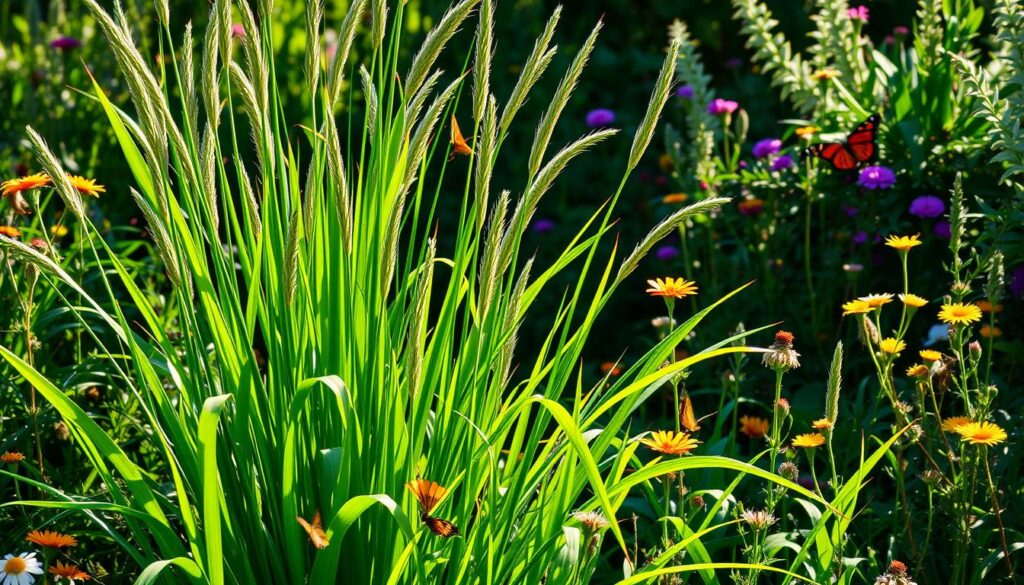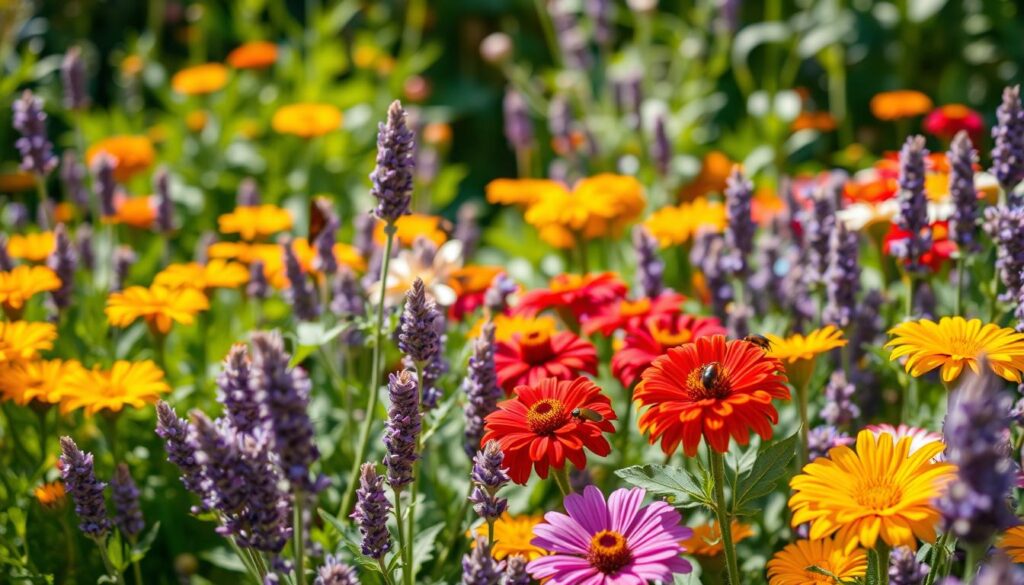Ever thought of a natural way to keep insects away without harsh chemicals? Your garden might hold the answer. Some flowers and plants naturally repel insects, making your outdoor space peaceful and free from pests. But which ones are the best at keeping bugs away? Let’s dive into the world of natural insect repellent plants and find out.
Key Takeaways
- Discover the power of plant-based insect repellents and how they work naturally to deter pests.
- Explore the benefits of using natural repellents over synthetic chemical options.
- Learn about the science behind plant defense mechanisms and their role in pest control.
- Identify the most effective insect-repelling flowers and how to incorporate them into your garden.
- Understand the importance of proper placement and companion planting for maximum pest control.
By using nature’s power, you can make a garden that lives in harmony with insects, without harsh chemicals. Let’s explore pest control plants and find the top natural insect repellents for your garden.
Understanding Natural Insect Repellent Plants
Keeping pests away in your garden is easy with plant-based repellents. These natural wonders release essential oils that hurt insects. This way, gardeners can have a beautiful outdoor space without harsh chemicals.
How Plant-Based Repellents Work
Plants have evolved to fight off pests. They use thick leaves and chemical defenses. These essential oils make it hard for pests to stay.
Benefits of Natural vs Chemical Repellents
Natural pest control is better for everyone. It’s safer for people, pets, and the planet. Plus, it helps keep your garden healthy and balanced.
The Science Behind Plant Defense Mechanisms
Plants have complex ways to fight pests. They make special compounds to keep pests away. By knowing this, gardeners can make their outdoor spaces strong and beautiful.
Which Flower Is Excellent at Repelling Insects?
Certain flowers are great at keeping pests away. Lavender, marigolds, and chrysanthemums are top choices. They are known for their strong ability to keep insects out of your garden.
Lavender has oils that can repel up to 80.9% of mosquitoes. Its scent also keeps moths, fleas, flies, and other pests away. This makes lavender a great choice for any garden.
Marigolds have a strong scent that repels aphids, mosquitoes, and other pests. These bright flowers have natural compounds that keep bugs away from vegetables and homes.
Chrysanthemums are also a powerful pest control plant. They contain pyrethrum, a strong insecticide. Pyrethrum fights roaches, Japanese beetles, bed bugs, spider mites, and ticks. These flowers are a strong defense against many insects.
| Flower | Insect Repellent Properties |
|---|---|
| Lavender | Deters moths, fleas, flies, and mosquitoes |
| Marigolds | Repel aphids, mosquitoes, and other garden pests |
| Chrysanthemums | Effectively control roaches, Japanese beetles, bed bugs, spider mites, and ticks |
Adding these best insect repelling flowers to your garden helps keep pests away. This reduces the need for harmful chemicals. It makes pest control more sustainable and eco-friendly.

“Incorporating natural pest control plants like lavender, marigolds, and chrysanthemums can create a beautiful and thriving garden while keeping insects at bay.”
Lavender: The Aromatic Guardian
Lavender is a special herb that smells amazing and keeps insects away. It grows well in sunny spots with good drainage. This makes it perfect for gardens that save water and indoor areas too.
Growing and Care Tips
Growing lavender is easy. It needs lots of sunlight and soil that drains well. Pruning and deadheading help it look good and bloom more. Lavender is great for both new and experienced gardeners.
Repellent Properties and Uses
Lavender’s scent is not just nice to smell; it also keeps insects away. Lavender oil can keep mosquitoes and flies off. It’s also good for your skin, a natural way to keep bugs off without harsh chemicals.
Best Placement in Garden
Put lavender near places where you sit or enter your garden. Its smell keeps mosquitoes and flies away. This lets you enjoy your garden without bugs bothering you. Using lavender pest control makes your garden a peaceful place.
| Pest | Repellent Effect |
|---|---|
| Mosquitoes | Highly effective, especially against the Anopheles stephensi species |
| Flies | Deters a variety of fly species, including houseflies and fruit flies |
| Moths | Repels moths, including the common clothes moth |
| Fleas | Effective in deterring fleas, making it useful for pet-friendly gardens |
“Lavender’s aromatic compounds act as a natural barrier, repelling a wide range of insects and creating a harmonious, pest-free environment in the garden.”
Adding growing lavender to your garden is a smart move. It makes your garden a natural and effective lavender pest control area. This improves your garden’s look and feel.
Citronella Grass: Nature’s Mosquito Defense
Citronella grass is a strong natural insect repellent. It belongs to the Cymbopogon family. This plant can keep mosquitoes away, especially those that carry malaria, by up to 100%.
Citronella grass loves sunny spots and well-draining soil. It can grow in pots or directly in the ground. In South Florida, it thrives year-round. In other places, it’s an annual plant. Its scent, like lemon, hides the smells that attract mosquitoes, keeping them away.
Lemongrass is also in the Cymbopogon family and repels mosquitoes like citronella grass. Both plants have essential oils with citronellal. This compound keeps mosquitoes and other biting insects away. Adding these plants to your garden can make your outdoor areas safer and more enjoyable.
Explore more on natural mosquitorepellent
“Citronella grass is a game-changer in the battle against mosquitoes. Its powerful aroma and proven efficacy make it a must-have for any outdoor oasis.”

Marigolds: The Colorful Pest Controller
Marigolds add beauty to any garden. But they do more than look good. They are known for keeping pests away, making them a great help in your garden.
Varieties for Pest Control
There are about 50 types of marigolds. You can pick from African, French, and Signet marigolds for pest control. Each type has its own way of keeping pests away.
- French marigolds have a strong smell. It keeps aphids, whiteflies, mosquitoes, and nematodes away.
- African marigolds have a less strong smell but still keep spider mites and other insects away.
- Signet marigolds are small but colorful. They make beautiful borders that also keep pests out.
Companion Planting Benefits
Marigolds are good on their own and even better with other plants. They protect vegetables and herbs from pests. This is a smart way to keep your garden safe.
| Companion Plant | Pest Targeted |
|---|---|
| Tomatoes, Peppers, Potatoes, Eggplants | Mexican bean beetles, Nematodes |
| Cabbage, Leafy Greens | Cabbageworms, Corn earworms, Japanese beetles |
| Beans, Squash, Potatoes | Aphids, Squash bugs, Striped pumpkin beetles, Whiteflies |
By putting marigolds in your garden, you make a natural defense system. It helps keep your crops safe from pests.
Basil: A Dual-Purpose Hero
Looking for a plant that’s good for cooking and keeps pests away? Basil is your answer. It makes your food taste better and keeps bugs out of your garden.
Basil smells great because of special compounds like estragole and limonene. These help keep mosquitoes, flea beetles, and cabbage webworms away. It’s a great addition to any garden.
To use basil to keep bugs away, just place fresh leaves around your outdoor spots. Or crush them to release their scent. You can even make a spray to keep pests off without using harsh chemicals.
Basil loves the sun and good soil. Adding it to your garden means you get tasty food and a natural way to keep pests away. Learn more about caring for your garden here.
| Basil Variety | Pest Control Efficacy | Culinary Uses |
|---|---|---|
| Sweet Basil | Mosquitoes, flea beetles, cabbage webworms | Pesto, sauces, marinades, salads |
| Lemon Basil | Mosquitoes, aphids, whiteflies | Teas, salads, marinades, garnishes |
| Thai Basil | Aphids, thrips, spider mites | Curries, stir-fries, marinades |
Adding basil to your garden gives you tasty food and a natural way to keep pests away.

“Basil is not only a delicious herb, but it’s also a natural insect repellent that can help keep your garden pest-free without the use of harsh chemicals.”
Rosemary: Mediterranean Pest Defense
Rosemary is a fragrant herb from the Mediterranean. It’s great for keeping insects away. It’s perfect for gardens or outdoor areas. It helps keep mosquitoes and pests off your veggies.
Growing Conditions
Rosemary loves warm, sunny spots with good drainage. You can grow it in pots, gardens, or beds. Taking good care of it helps it fight pests better.
Making Natural Sprays
Creating a homemade spray from rosemary is easy. Boil dried rosemary in water to get its oils. This makes a DIY insect repellent. Use it to keep mosquitoes and flies away.
Burning rosemary on grills or in pits also keeps pests away. It’s a great addition to your Mediterranean herbs and rosemary pest control tools.
| Pest Repelled | Rosemary’s Effectiveness |
|---|---|
| Mosquitoes | Highly effective |
| Flies | Moderately effective |
| Vegetable Pests | Highly effective |
Rosemary is a must-have for gardeners and outdoor lovers. It’s easy to grow and keeps pests away. Add it to your garden or living space for a natural, rosemary pest control solution.
Chrysanthemums: The Powerful Protector
Chrysanthemums are known for keeping pests away. They have a natural compound called pyrethrum that fights many pests. This includes roaches, ants, ticks, and fleas. Gardeners have used chrysanthemums for centuries to keep pests out of their gardens and outdoor spaces.
Chrysanthemums are not just good at keeping pests away. They come in different types, each with its own strength against pests. This makes them a great choice for controlling pests naturally. You can even make your own insecticide from the pyrethrum in chrysanthemums.
| Chrysanthemum Pest Control Attributes | Benefits |
|---|---|
| Pyrethrum Content | Highly effective against a wide range of pests, including mosquitoes, ticks, ants, and more. |
| Diverse Varieties | Offer varying levels of insect-repelling properties, providing gardeners with flexible options. |
| Natural Insecticide Potential | Allows gardeners to create their own homemade, natural pest control solutions. |
Chrysanthemums are great for keeping your garden or outdoor space pest-free. They are a strong ally in your fight against pests. Use the chrysanthemum insecticide in these flowers to keep your space safe and healthy.

Mint Family Plants for Pest Control
Gardeners looking for natural pest control can use mint family plants. Peppermint and spearmint are great at keeping away mosquitoes, flies, and spiders. Their strong essential oils help repel insects, making them perfect for herb gardens.
Catnip is also good at keeping mosquitoes, flies, and cockroaches away. It has a compound called nepetalactone that keeps pests at bay. Mint plants should be in pots to prevent them from spreading too much. Fresh or dried, these herbs are a natural and effective way to keep pests out of your herb garden.
| Mint Family Plant | Pest-Repelling Properties |
|---|---|
| Peppermint | Repels flies, fleas, spiders |
| Spearmint | Repels mosquitoes, flies, spiders |
| Catnip | Repels mosquitoes, flies, cockroaches |
| Sage | Repels cabbage moths and butterflies |
| Lemongrass | Naturally repels mosquitoes |
Adding mint insect repellent and other fragrant herbs to your herb garden insects can create a natural barrier. This barrier protects your plants and makes your outdoor space look better.
Best Garden Placement Strategies
Creating an effective garden layout for pest control means placing insect barrier plants smartly. Put them around the garden’s edges and inside. This way, you can keep pests away.
Creating Protective Barriers
Start by planting insect barrier plants like lavender, citronella grass, and marigolds. These plants are not only pretty but also keep pests away. Plant them in a line to block pests from getting in.
Combining Different Repellent Plants
Make your pest control better by mixing different insect barrier plants. For example, put citronella grass or lavender near where you sit to keep mosquitoes away. Use plants together to protect your garden’s weak spots. This way, your garden stays healthy and pest-free.
Think about the wind when placing your insect barrier plants. Put them downwind from busy spots. This helps them keep pests away better, making your garden a nicer place to be.

“A well-planned garden layout with a diverse array of insect barrier plants can be a powerful and sustainable solution for controlling pests in your outdoor space.”
Seasonal Maintenance Tips
To keep your garden healthy and pest-free, follow a seasonal maintenance plan. Regular pruning and care are crucial for your natural insect repellent plants. Prune and trim plants like lavender, citronella, and marigolds to boost growth and essential oil production.
Harvest herbs like basil and rosemary before they bloom for best results. This helps keep their pest-fighting compounds strong. Also, replace annual plants like petunias and dill with new ones each season to keep them effective.
- Adjust watering and care routines based on seasonal needs to keep your plants thriving and pest-free.
- Consider bringing potted repellent plants indoors during colder months to protect them and maintain year-round pest control.
By focusing on seasonal gardening tasks and plant care for repellents, your year-round pest control will stay strong. Your seasonal gardening will also flourish.
“Regular maintenance and seasonal adjustments are key to keeping your natural insect repellent plants healthy and primed for maximum pest-fighting performance.”
Common Mistakes to Avoid
Using natural flowers and herbs to keep pests away can be tricky. Homeowners often make mistakes that can harm their gardens. By avoiding these errors, you can have a beautiful, pest-free outdoor area.
Planting Errors
One big mistake is overcrowding plants. This can cause poor air flow and make plants more likely to get sick or infested. Make sure to give your plants enough space to grow well.
Also, not watering and fertilizing plants right can weaken them. This makes them more susceptible to pests.
Another error is depending too much on invasive plants like mint for pest control. Mint can spread fast if not kept in check. Mix different plants to keep your garden balanced and healthy.
Maintenance Missteps
Pruning too much can harm your plants. It can weaken their defenses against pests. Prune carefully and keep your plants healthy.
Lastly, only using plants for pest control isn’t the best plan. Plants are helpful, but they should be part of a bigger strategy. This includes picking pests by hand, using row covers, and attracting good bugs.
By avoiding these mistakes and using a complete approach to pest control, you can have a green, pest-free garden.

Conclusion
Natural pest control, eco-friendly gardening, and insect-repelling plants are great for a healthy outdoor space. Spider plants, Anthuriums, and snake plants are examples of plants that keep pests away. They also make your garden look beautiful.
Adding these plants to your garden helps create a balanced, eco-friendly space. This supports good insects and pollinators. By placing them wisely, you can protect your garden all year without harsh chemicals.
With the right planning and care, you can use nature to keep your garden healthy and free of pests. Enjoy the benefits of natural pest control, eco-friendly gardening, and the beauty of an insect-repelling garden. It’s a rewarding and green way to enjoy your outdoor space.


